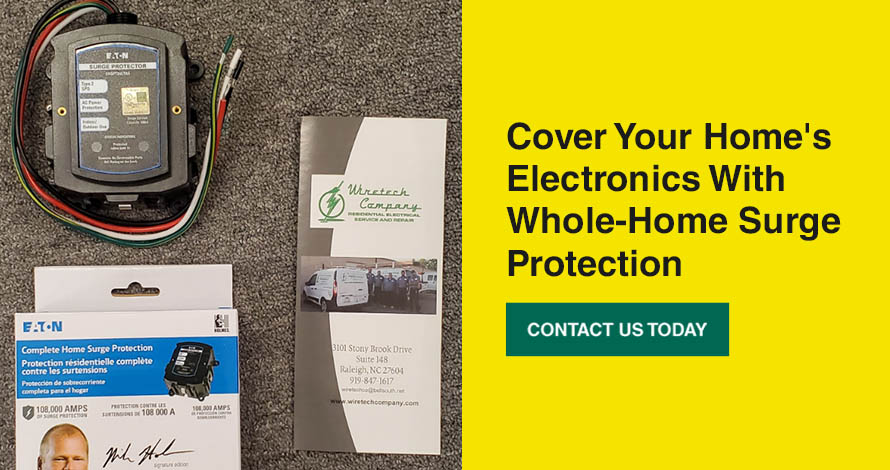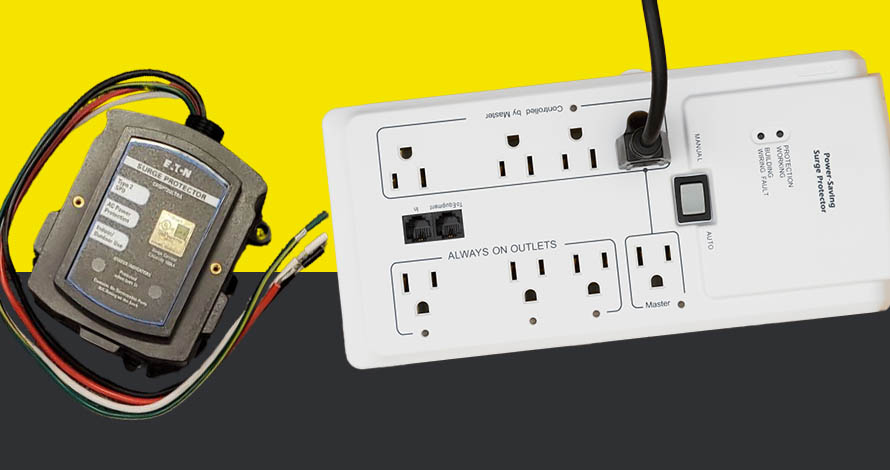
Protecting your sensitive and valuable electronic devices is far more cost-effective than replacing them in the event of a surge. However, electrical surges can be complex, with many variables influencing when and how they occur. As a result, understanding what electrical surges are and the basics of surge protectors is a key part of keeping your appliances and devices protected.
This guide will cover everything you need to know about protecting your home from surges. By looking at the different options and considerations, you can find the best whole-home protection to suit your needs.
What Are Electrical Surges?
Electrical surges are sudden, temporary increases in voltage that can significantly impact a building’s electrical system. There are two categories of electrical surges — external and internal.
- External: External surges result from events like lightning strikes or power grid issues. When lightning hits a power line or nearby structure, it sends a massive surge through the electrical system. Power outages, tripped circuit breakers and damaged electronics often follow.
- Internal: Internal surges stem from appliances cycling on and off, faulty wiring or other internal factors. When a surge occurs, the excess voltage can harm electronic devices connected to the electrical system.
Over time, repeated exposure to surges will shorten device and appliance life span. Regular maintenance of electrical systems, including checking wires and using surge protection devices, is essential to prevent issues caused by electrical surges. Understanding the sources of and potential consequences of surges empowers homeowners to take proactive measures.
The Basics of Surge Protectors
Surge protectors act as barriers between electronic devices and power sources. They work by diverting excess voltage from connected equipment, preventing potential damage. Inside surge protectors are metal oxide varistors (MOVS) or gas discharge tubes (GDTs), which detect voltage spikes and redirect excess energy to the grounding wire.
When the voltage exceeds a safe threshold, these components absorb the extra electricity, safeguarding the devices. Surge protectors include joule ratings that indicate how much energy they can absorb.
Overall, surge protectors provide vital defense against unpredictable electrical fluctuations, helping ensure the safety and longevity of your electronics.
Types of Surge Protectors
Surge protectors come in various types and models, including:
- Whole-house surge protectors: These are installed by mounting them at the main electrical panel. They will safeguard the entire home from external surges and certain types of internal surges. This type of protector provides comprehensive protection and reduces the risk of damage to all connected devices.
- Point-of-use surge protectors: Point-of-use protectors are installed at individual outlets. They protect specific devices plugged into the protected outlet. Safeguarding individual electronics is the ideal way to use this device. These protectors are most useful for computers and home entertainment systems.
- Power strip surge protectors: This kind of protector combines multiple outlets with surge protection features. It offers a compact solution for protecting and connecting several devices at once. It’s best suited for areas with limited wall outlets.
- Plug-in surge protectors: These protectors plug directly into wall outlets. Plug-in surge protectors are easy to move between outlets as needed. They do not require complex installations.
- Smart surge protectors: Smart surge protectors integrate with smart home systems, allowing for remote monitoring and control. They are often equipped with Wi-Fi or Bluetooth capabilities. These protectors allow users to manage surge protection status through a smart device.
- Hardwired surge protectors: These surge protectors are integrated directly into the electrical system. Hardwired surge protectors provide a permanent and discreet surge protection solution. They are suitable for those looking for long-term surge protection without visible devices.
- Uninterruptible power supplies (UPS): UPS devices combine surge protection with battery backups. They ensure uninterrupted power to connected devices during outages. This is the ideal solution for backing up critical electronics that need surge protection and a temporary power supply.
- Outdoor surge protector: These devices are specifically designed for outdoor use. They are weather-resistant and built to endure exterior environments. They can protect outdoor electronic equipment like landscape lighting and surveillance cameras from surges.
The Benefits of Getting a Surge Protector
Investing in the right surge protection for your home is a cost-effective and wise choice. Keeping your devices safe brings peace of mind and prevents you from having to replace devices due to surge damage. These are the biggest advantages that having a surge protector can offer you and your home:
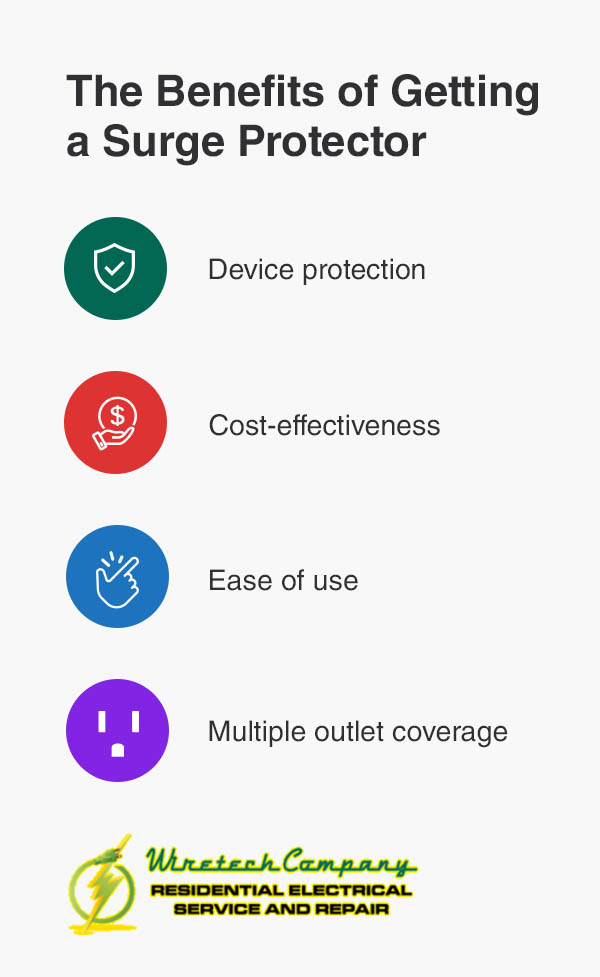
- Device protection: Surge protectors shield electronic devices from voltage spikes. This protects them from any damage caused by electrical surges. These protectors act as a first line of defense for sensitive equipment like computers, TVs, kitchen appliances and more.
- Cost-effectiveness: Surge protectors are relatively affordable compared to the potential costs of replacing or repairing damaged devices. Investing in whole-home surge protection can save you money in the long run by extending the life span of electronics.
- Ease of use: Surge protectors are easy to install and require minimal maintenance. Users simply need to plug their devices into the protected outlets. Surge protectors provide a convenient and hassle-free solution for safeguarding electronics.
- Multiple outlet coverage: Many surge protectors come with multiple outlets, allowing users to connect several devices simultaneously. This feature is particularly beneficial in rooms with limited wall outlets. Providing a convenient way to power multiple electronics, office setups and entertainment systems.
Are Surge Protectors Required?
Published by the National Fire Protection Association, the National Electrical Code (NEC) is a list of standards that ensure the safe installation of electrical equipment. Every three years, the NEC is revised to include updated standards and regulations. Many updates regarding surge protectors came out in the 2020 edition. These updates received more clarification in the 2023 edition.
Though NEC standards have been published for decades, it wasn’t until 2020 that surge protection became a legal requirement according to NEC standards. The 2020 edition recommends that electricians use Type 1 or 2 surge protection devices (SPDs) during service replacements and upgrades to increase whole-house protection in dwelling units.
In 2023, the NEC expanded the definition of “dwelling unit” to include guest rooms, dormitory rooms, patient sleeping rooms in nursing homes and guest rooms in hotels and motels, specifying that any unit where a person might live, stay or dwell must now be protected.
Are Surge Protectors the Same as Power Strips?
A common misconception about surge protectors is they are interchangeable with power strips. The truth is these are two different kinds of equipment, each made for different functions and situations. Here are the main differences to understand:
Surge Protectors
Surge protectors are primarily used to protect electronic devices from voltage spikes or surges. They divert excess energy away from connected equipment to keep devices safe from being exposed to damaging amounts of electricity. As a result, surge protectors contain components like MOVs to absorb and dissipate excess voltage. These protectors offer varying levels of protection measured in joules. A high joules rating indicates a greater capacity to handle surges.
Of course, surge protectors do not last forever. Replacing them is necessary for optimal protection after significant surges, or at least every three years. Further, comprehensive surge protection requires an initial investment. They cost more than basic power strips due to the added surge protection features.
Ultimately, surge protectors are ideal for protecting sensitive electronic equipment against voltage fluctuations. It’s recommended to use surge protectors to safeguard computers, TVs, gaming consoles and other expensive devices.
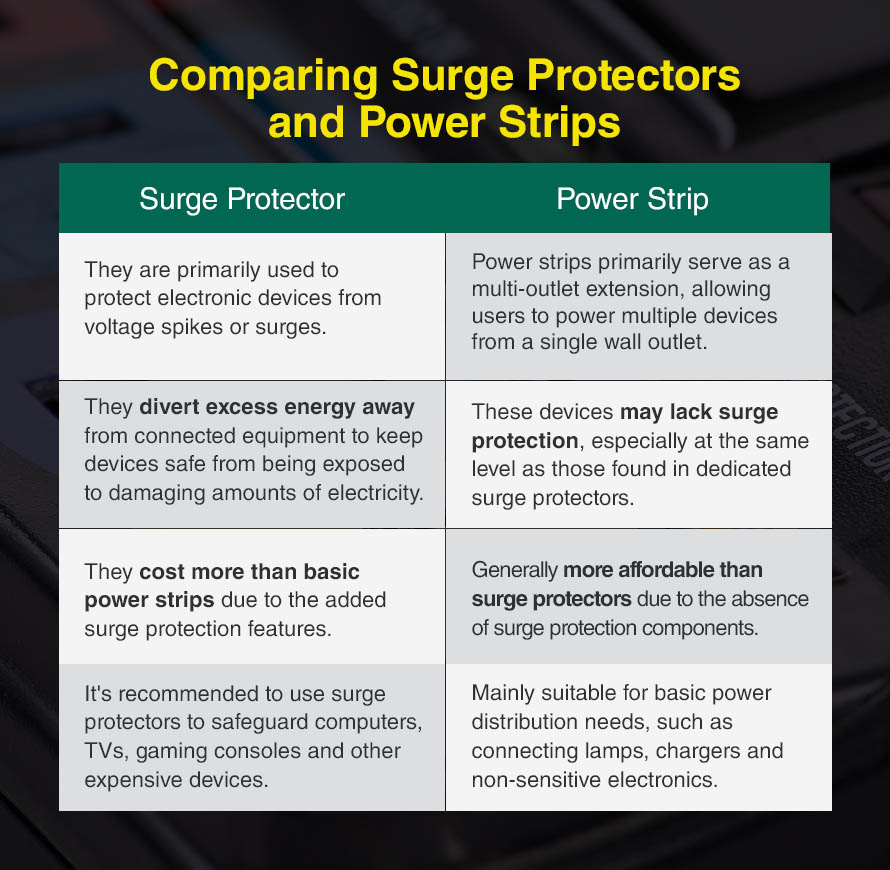
Power Strips
In comparison, power strips primarily serve as a multi-outlet extension, allowing users to power multiple devices from a single wall outlet. These devices may lack surge protection, especially at the same level as those found in dedicated surge protectors. A power strip without surge protection elements will only extend the number of outlets through which you can power your devices.
Power strips are generally more affordable than surge protectors due to the absence of surge protection components. They are mainly suitable for basic power distribution needs, such as connecting lamps, chargers and non-sensitive electronics.
Do Surge Protectors Protect HVAC Units?
Surge protectors can protect heating, ventilation and air conditioning (HVAC) units. Surges caused by lightning strikes and power grid fluctuations can threaten sensitive components that use a lot of power, including HVAC units. While surge protectors may not be commonly associated with HVAC protection, this equipment still often includes electronics. As a result, surge protectors can play a role in protecting them from damage.
Surge protectors work to safeguard HVAC systems in the following ways:
- Voltage regulation: Surge protectors can detect sudden increases in voltage in HVAC units. They will divert the excess voltage from the units when a surge occurs. This helps maintain a stable and safe voltage level for the system.
- Electronics protection: HVAC units include multiple electronic components. These include sensors, control boards and motors. Surge protectors shield these delicate electronic components from voltage spikes that would cause permanent damage or malfunctions.
Surge protectors can be strategically installed at various points in an electrical system, including dedicated HVAC circuits or the main electrical panel. Doing this will ensure surge protection is directly applied to the specific equipment or area requiring safeguarding.
While surge protectors contribute to HVAC protection, it is important to note that specialized surge protectors designed for HVAC systems may provide more tailored features for comprehensive protection.
What Is the Best Whole-Home Surge Protector for You?
Whole-home surge protection costs vary, but they are worth it for any homeowner with high-value appliances, intricate electronic setups or a home office. You can choose the best whole-home surge protector by considering factors like volt protection rating, ease of installation and warranty. Look for reputable brands and select a model suitable for your home’s electrical panel size. Prioritize surge protectors with indicator lights for status monitoring and opt for one with a connected equipment warranty for added peace of mind.
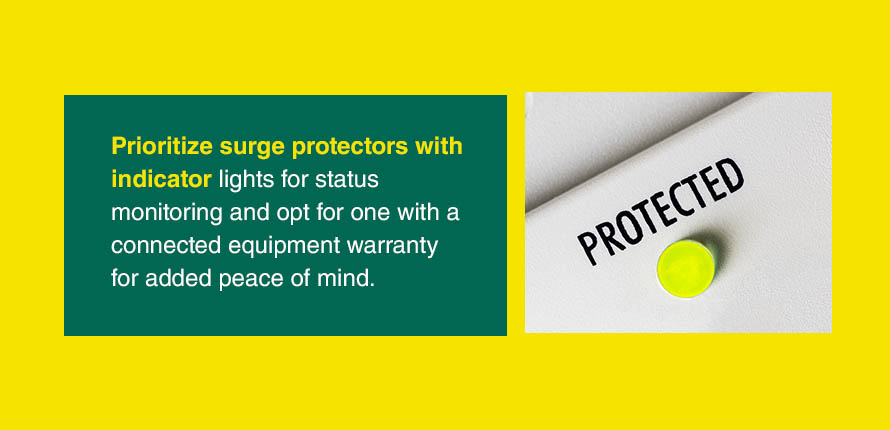
Additionally, evaluate the surge protector’s response time. Quicker response times offer better protection. Consider consulting a professional electrician to ensure compatibility and proper installation. Read customer reviews to gauge the surge protector’s reliability and overall performance, and assess your budget to find a whole-home surge protector that balances your protection needs with cost-effectiveness.
The weather also plays an influential role in choosing the right surge protector. Raleigh, North Carolina, experiences a four-season subtropical climate, with hot, humid summers and cool, mild winters. There is also occasional severe weather, such as thunderstorms. As a result, residents should prioritize robust surge protection for their electronic devices. A whole-home surge protector installed at the electrical panel can protect your home from the risks of lightning or hurricanes breaking power cables and infrastructure. Investing in weather-resistant surge protectors for outdoor devices is also a smart idea.
Surge Protector Maintenance Tips
Maintaining your surge protectors is important to ensure they operate properly. As a result, you’ll want to note the following surge protector maintenance tips to keep your equipment in top condition:
- Prioritize proper installation: Surge protectors need to be properly installed to guarantee optimal protection. Always consult a professional electrician to assess your home’s electrical system and install your chosen surge protector.
- Do regular inspections: Periodically check surge protectors for any physical damage, wear or discoloration. Replace units showing signs of wear.
- Check indicator lights: If your surge protector has indicator lights, monitor them regularly. These lights often signal if the device is still providing adequate protection.
- Have a replacement schedule: Surge protectors have a finite life span. Consider replacing them every two to three years, especially if they have experienced significant power surges.
- Avoid overloading: Try not to overload surge protectors by connecting too many devices simultaneously. Follow the specified load capacity to prevent overheating and reduced protection.
- Test functionality: Some surge protectors have a test button you can press to see if they still function correctly. Periodically press this button to confirm proper operation.
- Check for secure connections: Ensure all devices are securely connected to the surge protector. Loose connections may reduce protection.
It can also be highly beneficial to work with an experienced residential electrician services team to ensure your surge protectors work as intended.
Cover Your Home’s Electronics With Whole-Home Surge Protection
Surge protectors for your home can provide comprehensive protection for your appliances and electrical devices. At Wiretech Company, we take surge protection seriously, and we can help you figure out the best whole-house surge protection solution for your property. We’ve served the Raleigh area for decades, and our team understands the area perfectly, allowing us to provide you with solutions that safeguard your home from minor and large surges alike.
Contact us today, and we’ll assess your house for proper surge protection and put together the most effective approach so you can keep your crucial devices protected.

